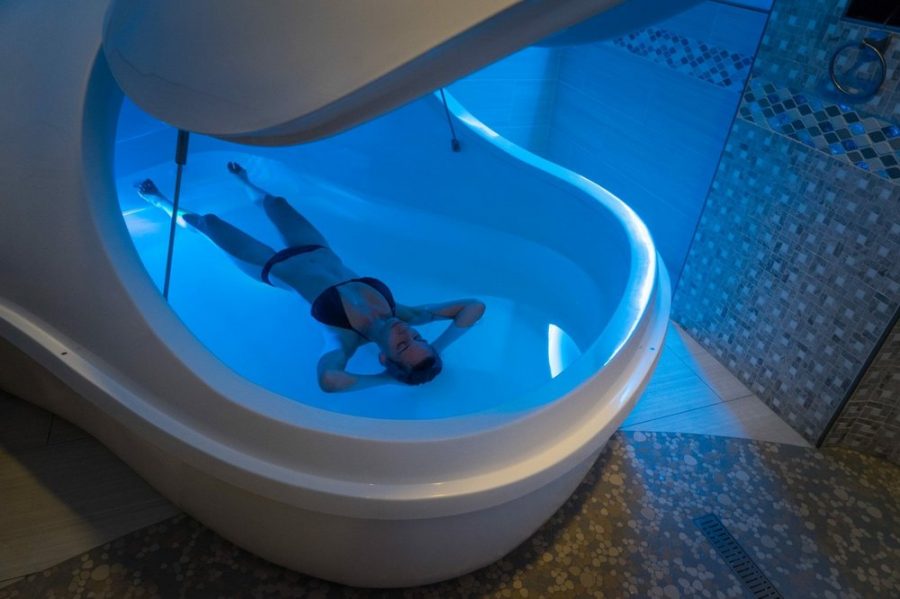Float Therapy
The popularization of sensory deprivation therapy
March 8, 2018
You cannot see. You cannot hear. You are floating. Sensory deprivation tanks or “float” tanks are used as a holistic approach to wellness.
These 180 gallon tanks are light and sound proof, and they are filled with over 1,000 pounds of salt. Adding the gargantuan amount of salt to the tank creates a 30% salt solution, which allows you to float.
According to Nathan Heller from Vogue Magazine, “The floatation tank appeared more welcoming than I had expected. It was white and sleek, and it gaped amiably, like a big clam. Far from being sepulchral, it was huge—almost the width of my arm span, I guessed—and comfortably rounded.”
Sensory Deprivation tanks were invented during the 1950’s by neuroscientist Dr. John Lilly. His goal was to examine the effects of the brain when all stimuli like light and sound were cut off. During Lilly’s studies, he found that the brain does not rely on external information to remain vibrant. In the 1970’s a young couple, Glenn and Lee Perry, began exploring sensory deprivation tanks. The Perry’s took ideas from Dr. Lilly’s initial experiment and began marketing them for commercial use.
Flotation tank centers became popularized in the late 1970’s and 1980’s by celebrities like John Lennon and Robin Williams. The flotation industry was on the decline for many years due to Acquired Immunodeficiency Syndrome or AIDS; many people were unsure how this disease spread and wanted to play it safe. Recently, float therapy has been marketed more than ever because of its health benefits.
Over the past decade, nearly five floatation spas have popped up in the Omaha metro area. They all have the same concept, but tank design differs spa to spa. These spas include True REST Float, Omaha Float, Float Center and Afloat.
Each float, which usually lasts from 40 to 60 minutes, costs around 60 dollars. Although these floats are pricey, they have a multitude of benefits.
The Epsom Salts in the tank help to prevent inflammation and treat sprains, strains or sore muscles. They naturally exfoliate your skin and aid in creating a weightless environment. Having an anti-gravity environment allows for the spine to elongate, blood circulation to increase, and lets your body completely relax.
The lack of stimuli can help with stress management and sleep schedule maintenance. Decreased external information lets the brain enter into deep relaxation; the brain releases waves with a slower frequency and mimics an intense state of meditation. Float therapy can be used to alleviate feelings of “jet-lag” because of the calm state the brain enters.
Often, people who suffer from anxiety or Post Traumatic Stress Disorder are given lorazepam, prescription drug marketed to relieve symptoms of anxiety. Lorazepam shuts down a part of the brain called amygdala, which controls your survival instincts and emotions.
Neuroscientist Justin Feinstein was fascinated with the effects of floating, so he created a study to learn more about the phenomenon.
According to Time Magazine, “He scanned everyone’s brain before the experiment started, and then split his group of volunteers in half. Both groups got what they believed to be the intervention: either a 90-minute float or the same amount of time in a relaxing reclining chair. He gave everyone two sessions to let the novelty of the interventions die down, and then scanned their brain after the third session.”
Feinstein found that the floating mimicked effects of lorazepam; the amygdala started to shut down post float.
Floating could be extremely helpful to those who suffer from anxiety. Many anti-anxiety drugs are be highly addictive, and floating can achieve the same effects.
Over 200 floatation centers have opened since 1990 and continue to grow. Trends come and go, but floating could be here to stay because of its effects.


















Salena • Nov 7, 2019 at 5:09 am
Thank you for the wonderful write up.
At iSofloat spa San Antonio, we offer the best floating therapy. Float therapy is a sensory deprivation practice that allows you to reach levels of deep relaxation and physical recovery.